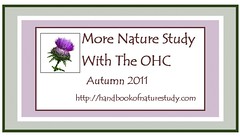
"While the chipmunk is a good runner and jumper, it is not so able a climber as is the red squirrel, and it naturally stays nearer the ground."
Handbook of Nature Study page 239
OHC More Nature Study #6
Chipmunks
Inside Preparation Work:
- Read in the Handbook of Nature Study pages 239-241 (Lesson 58). Take note of the differences between a squirrel and a chipmunk.
- Listen to Chp. 6 in The Burgess Animal Book For Children: Striped Chipmunk and His Cousins.
- View this website that has simple information for chipmunks and squirrels: Backyard Nature: Squirrels.
- Optional YouTube video: Chipmunk in Slow Motion.
 |
| Golden Treasury of Natural History from 1952 |
- Go on a chipmunk hunt! Spend a few minutes of your Outdoor Hour time for this challenge looking for chipmunks. Chipmunks and squirrels are diurnal, or active during the day.
- If you observe a squirrel instead of a chipmunk, make some observations and comparisons. Compare color, stripes, tail, and behavior.
 |
| Golden Treasury of Natural History from 1952 - love the expression |
- Give the opportunity for discussion and follow-up to your chipmunk hunt. Complete a notebook page (ebook users), a nature journal page, and/or the coloring page (ebook users only) for you nature journal.
- Advanced Follow-Up: Compare a chipmunk and a squirrel by careful observation. Subjects can include: stripes, tails, behavior, diet, size, voice.
- Advanced Follow-Up: Research and record in your nature journal about the method the chipmunk uses for building his home. There is a notebook page in the ebook to record your study.
Additional Links:
Chipmunk Lapbook and Unit Study on HomeschoolShare.com
For Advanced Study: Chipmunks 101 on Squidoo.com

Make sure to share your entry with the Outdoor Hour Challenge Blog Carnival. Please jump in even if this is your very first OHC. All you need to do is share the link to your blog entry. Easy as pie.
 Now for our Giveaway!
Now for our Giveaway!The winner of the Circle Time - Plan The Best Part of Your Day is Kelsey from Mud Puddles.
Congratulations!
